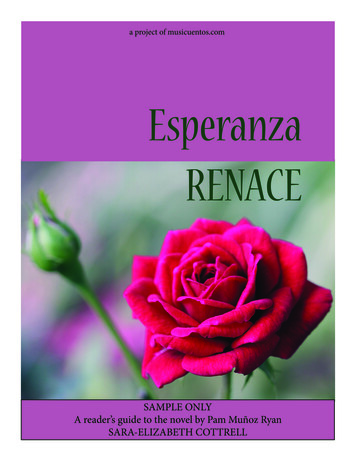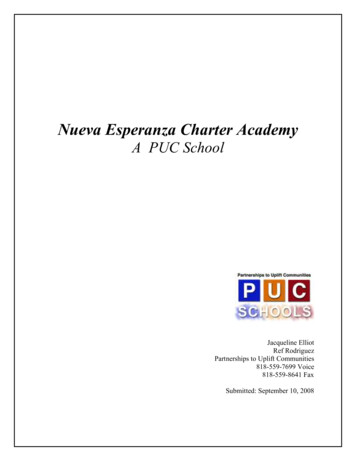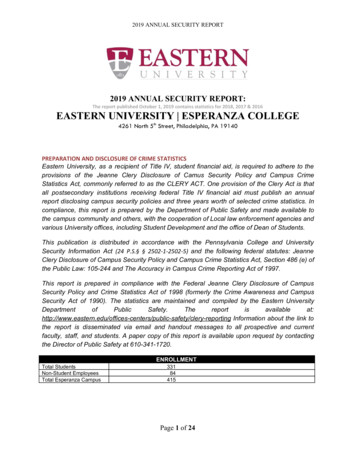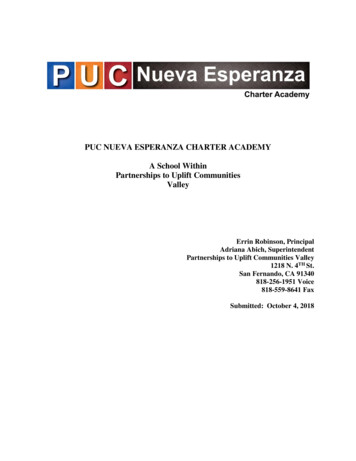
Transcription
a project of musicuentos.comEsperanzaRENACESAMPLE ONLYA reader’s guide to the novel by Pam Muñoz RyanSARA-ELIZABETH COTTRELL
Copyright 2019 Sara-Elizabeth CottrellPurchase includes the rights to reproduce or digitally distribute the document for the students of the purchasing teacher. Not transferable after use. Respect copyright law and do notshare this document outside this indicated use.If you have received this file/document for free from someone other than your teacher or theauthor, you are violating digital copyright laws. Please support the author by visitingmusicuentos.com/ebooks to purchase a legal copy.The novel Esperanza renace is copyright 2000 by Pam Muñoz Ryan (Spanish translationcopyright 2002 by Scholastic, Inc.). All rights reserved.
IntroductionWelcome to the Reading Guide for Esperanza renace, the hope-filled historical novel by Pam Muñoz Ryan.Every section and activity in this guide is designed to improve students’ proficiency.VocabularioEach chapter is prefaced by a section called Vocabulario. This section introduces the vocabulary in the chapterand suggests activities that will boost memory and get readers talking about the vocabulary in the chapter. Vocabulario: This section lists words and phrases often important to understanding the events of thechapter. Many of these words may already be familiar to students, especially heritage learners. Manyare probably not familiar to them. These lists are extensive and contain much more vocabulary thanreaders will be able to actually aquire in one pass. That’s okay. By exploring the meanings of thesewords before reading the chapter, students will have a resource for when they need help with the eventsof each chapter.Words and phrases in bold italic, including idiomatic expressions and sequencing words, are eitherfrequently used in communicative Spanish or are critical to understanding the plot of the chapter/novel. Translations of the words are not included so that you can determine how students interactwith the meanings of the words. All words and phrases and their English translations are listedalphabetically in a glossary at the end of this guide. A repasar: Each chapter includes a list of vocabulary words learners should be familiar with frompast Spanish experiences or that were previously mentioned in a Vocabulario section. Sometimesthese words are variations of previously used words. Note how variations help readers figure out whatthe word means and are often caused by a change in the use of a word, such as changing a verb to anadjective. The Vocabulario activity after the list asks questions that enhance memory by causing readers to relatevocabulary meaningfully to the world around them. The Relaciones activity boosts memory by asking readers to make connections among vocabularywords. Are they all parts of the body? Things that you wear? Emotions? Opposites? How can youexpress these connections in Spanish? The Diccionario visual activity recognizes that the human brain remembers more when a pictureis attached to a word. Readers are encouraged to look up several vocabulary words using GoogleImages. (Note: I have looked up every word I recommend students to view, but Google Images canbe inappropriate at times. Be sure to use the whole word/phrase where I have included it and turn onGoogle’s Safe Search.) The Dominio activity asks learners to perform a task specifically related to improving their proficiency,such as describing a scene or process or narrating a story. The Conversación activity gives students the opportunity to practice interpersonal speaking by talkingwith a classmate or friend about something related to the chapter and its vocabulary. Some chapters include a section called Viejo y nuevo that invites readers to relate previous knowledgeto new vocabulary or language concepts.3
Some chapters include a section called A ver, in which readers will sketch parts of the vocabulary tohelp them visualize it and boost long-term memory.The Imaginación con un modismo activity invites practice with idiomatic expressions, a key todeveloping advanced proficiency, in a way that uses their imagination, which boosts memory.The section called Idioma focuses meaningfully on how particular words are formed or function insentence.The section called Herramientas para el cuento offers specific advice on how Spanish learners canimprove their narration skills.Finally, each vocabulary section includes a Reflexión suggesting a journaling activity that will causestudents to reflect on events in their own lives in order to help them preview the chapter’s mainthemes.A leerThe second part of each “chapter” is a set of questions about the plot of the story, accompanied by proficiencyboosting activities. Reading questions are usually related to principal characters, major plot developments, or symbolicturns of events. Readers may need to think critically, express an opinion, or make a prediction aboutwhat they’re reading. Questions that have S at the beginning are directly related to one of the objects/concepts used in the book as major symbols (the doll, roses, the blanket). The Para ti activity asks readers to relate something in Esperanza’s story to their own world. This is akey skill in intercultural competence. El mundo de Esperanza invites learners to explore cultural concepts the author mentions in thechapter, such as songs, foods, or practices. The section called Los símbolos del libro points out the book’s major symbols used in that chapter.Readers are encouraged to chart how the symbols change in importance or use throughout the book.Teachers may consider using this perspective as a final presentation project related to the novel. The Para comprender más section offers comprehension-boosting activities such as making diagramsor character sketches or looking up pictures or videos of things or actions mentioned in the chapter.Above all, remember that the goal is is to increase communicative competence and improve proficiency inmotivating ways. I hope this guide helps intermediate and pre-advanced Spanish learners have even morelove for Spanish and the Spanish-speaking peoples—their joys, challenges, and traditions—and inspires themto be continually learning and improving their world.Sara-Elizabeth Cottrell4
Capítulo 3: Los higosVocabularioCOSASla barbillala bolsa de tejerla caridadel compromisolas cortinasel delantaldesgracialos higosuna maletamentiraun milagromodalesun osolos peldañossonrisael suelola toallael tobilloel vientoACCIONESabrazóacabas deagarró, agarrandoandarasintióconfiarcuidarían(se) dirigióenvolvióse fijó enimpediráse juntaronmarcharnosocultóodiopermaneció(se) pusoquedarserenacerieron(se) secósoplótaparonterminatoser(hayas) vencidovigilaránPARA HABLAR DEL FUEGO(se) apagóardían, estaba ardiendolas cenizaschispaslos escombroshumoel incendiollamasla quemadurase está quemando, quemabanlos restosYLBNEO/LE .COMPSAM NTOS ASEE RCHLUGARESUC PUIlas cabañasSla cima de la montaña UOMTla fronteraEEun hogar Sun internadola planta bajaA repasar:¿Ya sabes el sigificado de estaspalabras y frases? Repáselas.una canciónla carreta(se) dio cuenta de quedespiertalas escalerasfuertela habitaciónhaciaingresolevántatelas monjasla muñecala narizpadrastrotampocovacíaSKOOPARA DESCRIBIRafueraburlonaconfundidade vez en cuandodébildondequieraen deudaen voz bajafierohinchadomareadaparadospor todas partesPARA CONECTARa lo mejora través deal cabo deMODISMOS(me) alegro de quedio la vueltaestá segura deno tengo la menor duda / ideavolveré aNadie pudo contener lafuria del fuego que seextendió hasta las uvas.5
Vocabulario:¿Hace mucho viento donde vives tú? ¿Con muchafrecuencia o de vez en cuando?Señala el tobillo y la barbilla en tu dibujo del cuerpo humano.Dibuja una cara con una sonrisa y otra cara conuna mueca burlona.Añade un delantal a tu diagrama de la ropa.Cuando te marchas para hacer un viaje, ¿quépones en tu maleta?¿Cuáles estados de los Estados Unidos tienen unafrontera con México?Diccionario Visual:En images.google.com, busca imágenes para mejor comprender estos objetos y conceptos:los higos, un oso, cortinas, el tobillo, la bolsa, lospeldaños, una sonrisa, la barbilla, un delantal, unamaleta, cabañas, un internado, la cima de unamontaña (cerca de ti), humo, chispas, llamas, losescombros de un incendio, cenizas, toser, rieron,abrazó, ocultó, y una mueca burlona.Imaginación con un modismo:Termina las frases con palabras o frases imaginativas.Su mamá le dijo, “Hijo, no tengo la menor idea dedónde está tu ”Dominio:Probablemente ya sabes qué significa la frasecomún otra vez. Hay otras dos frases que tambiénse usan con mucha frecuencia para expresarque algo pasa otra vez. Mira estos ejemplos delcapítulo y decide cuál es la acción repetida y cómopuedes usar esa frase en tu comunicación.No temas empezar de nuevo.Volvería a dejar todo como estaba.Volvería a ser como antes.Herramientas para el cuento:SKOOPara contar un cuento, es mejor escoger verbosdescriptivos para una acción. Abajo hay ejemplosde este capítulo de verbos que la autora escogióusar en vez del verbo más común.caminar -- andarvio -- se fijó enfue -- se dirigióharé otra vez -- volveré aLY EBNO/EML .COPRelaciones:AM TOSlas llamas, las chispas, el humoESSquedarse, marcharseAEN RCHdébil, fuerteUC PUConversación:ISU TO Habla con un(a) amigo/a de las situaciones cuanReflexión:MSi tuvieras que salirde tu hogar ocultado/a en lado es mejor hablar en voz baja.EESnoche, ¿qué llevarías contigo? ¿Qué te haría mástriste al dejar atrás?“Esperanza llevabauna maleta llenade ropa.”6
Viejo y nuevo / A ver:En el diagrama de la casa que hiciste en el capítulo 2, señala la planta baja.En el cuadro aquí, dibuja y señala un fuego con estas partes que se mencionan en este capítulo.EL FUEGOel incendiolas llamaslas chispaslas cenizasel humoLY EBNO/EMLOPC.MA leerSA NTOS ASEHdel capítulo. (40)1. Describe brevemente el sueño que teníaEEsperanza al principioCURCIUS2. ¿Quién despertó a Esperanza,y por qué? (41)PUOMTEE Esperanza antes de salir de su habitación? (41)Sagarró3. S: ¿QuéSKOO4. ¿A quién buscaba Mamá afuera? (42)5. ¿Quién salvó a Abuelita? (43)6. ¿Se lastimó Abuelita? ¿Dónde? (43)Para ti:Si hubiera un incendio en tucasa, ¿cuáles 3 cosas salvaríasantes de escaparte?7. S: ¿Qué tenía Abuelita consigo, que salvó de la casa? (43)8. ¿Se quemaron también las uvas? (43)9. ¿En dónde durmieron Esperanza, Mamá y Abuelita esa noche? (44)10. A lo mejor, ¿quiénes habían causado el incendio? (44)11. Al otro día, ¿qué quedó dentro del baúl de Esperanza? (45)7
12. ¿Qué le prometió hacer Luis para Mamá después de casarse con ella? (45)13. ¿Cómo respondió Mamá a la propuesta de Luis? (46)14. ¿Cómo reaccionó Esperanza a la respuesta de su mamá? (46)15. ¿Adónde quiere mandar Luis a Esperanza para que aprenda a “comportarse como una señorita”? (46)16. ¿Quiénes se reunieron en la habitación de Hortensia y Alfonso para hablar de sus opciones? (47)17. Según Alfonso, si Mamá no quiere casarse con Luis, ¿qué tiene que hacer? (48)18. ¿Cuál fue la decisión de Alfonso y Hortensia? (48)19. ¿Qué idea tiene Mamá para ella y Esperanza? (48)20. ¿Qué son las tres cosas que Esperanza no quiere dejar para salir deMéxico? (48-49)El mundo de Esperanza:Para comprender mejor la culturade Esperanza, busca informaciónde estos conceptos culturales:Los requisitos para entrar a losEstados Unidos desde México en1930 y ahoraLY OM/NO22. ¿Por qué será difícil cruzar la fronteraparaMamá y Esperanza?C (49) SEE.SLPOATMH23. A lo mejor ¿quiénesApodrían ayudar conNel problema de los papeles?(50)CESRUUCPI24. ¿Está lista Mamá para trabajaren el campo?(50)SOUTMSKE25. ¿Qué consejoledaAbuelitaaEsperanza?(50)SE BOOE21. ¿Qué vio Esperanza en la cara de su madre? (49)26. S: ¿Qué es el fénix? (51)27. ¿Qué dijo Esperanza que les hizo reír a los demás? (51)28. ¿Quiénes vinieron a buscar a Abuelita en el rancho? (51)29. ¿Por qué Esperanza y su abuela no podrán comunicarse? (52)30. S: ¿Qué le dio Abuelita a Esperanza? ¿Qué quería que hiciera? (52)31. S: Según Abuelita, ¿qué simbolismo tienen los valles? (52)32. ¿Qué promesa quería Abuelita de Esperanza? (53)8Los símbolos del libroEn tus notas de los símbolos,añade información acerca deestos símbolos del cuento:la muñecael tejidoel fénix y el fuegoel zigzag de la manta
33. ¿Qué había dentro del baúl que habían dejado las monjas? (53)34. ¿Para quiénes era “la ropa para los pobres”? (54)35. ¿Quién era la única persona en la que podían confiar? (54)36. ¿Cuándo regresaron los tíos? (54)37. ¿Cuál fue la respuesta de Ramona a la propuesta de Luis? (55)38. ¿Qué le pidió Ramona a Luis para facilitar las visitas a Abuelita? (55)39. ¿Qué llevaba Esperanza cuando salieron? (3 cosas) (56)SKOOLY EBNO/EML41. ¿Cuáles sentimientos sentía EsperanzaPal salir y dejarS.suCvida?O(57)MAOE42. Según Mamá, ¿qué estaráScon ellas dondequieraque vayan? (58)STANE RCHUC PUISUOMTPara comprendermejorEHaz SunEdiagrama de los sentimientos de Esperanza en este capítulo hacia estas personas, cosas o eventos.40. Cuándo salieron del Rancho de las Rosas, ¿adónde fueron? (57)Al experimentar el incendio (42)Al oír la primera respuesta de su mamá al tío Luis (46-47)Al despedirse de Abuelita (52-53)Al dejar su vida en México (58)El tío Luis (58)“.y la muñeca quele había regaladoPapá.”9
ImagesCover rose image credit to Dale at https://www.flickr.com/photos/dalesbest/All other images legally licensed from talented artists through Shutterstock, AdobeStock, or Pixabay.YLBNEO/LE .COMPMSAOSSETANE RCHUC PUISU TOMESE10SKOO
This is a key skill in intercultural competence. El mundo de Esperanza invites learners to explore cultural concepts the author mentions in the chapter, such as songs, foods, or practices. The section called Los símbolos del libropoints out the book’s major symbols used in that chapter.











